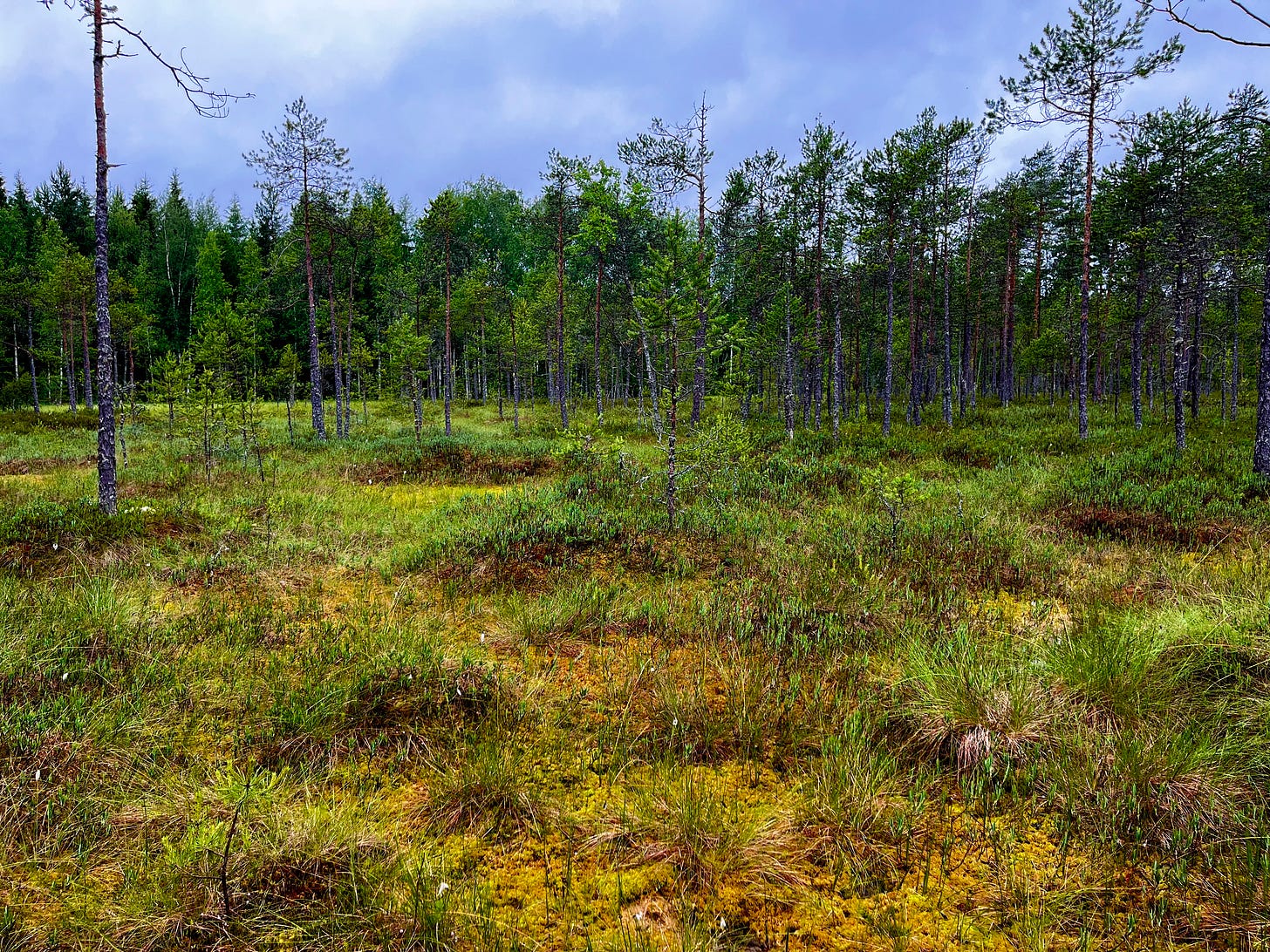Eye of the Bog — Silent Stillness Among the Smallest Details
Seeking the quagmire — found it! And a little world of new species
When we arrived to our cottage for the first few times, I noticed a bog behind the trees by the forested cottage road. I knew right away it was a must-go-place. This week, there was a rainy day, and I decided it was time for this new adventure.
We spoke about the bog at the dinner table, and I mentioned that we must beware of the 'eye of the bog' (literal translation of Finnish ‘suonsilmä’ which means a quagmire. I’m gonna call it that in this post.) It means the spot in a swamp where you shouldn’t step or you’ll sink into the bog. The kids got more excited. They started to wonder what would happen if you step there. The 3-year-old understood right away that you could drown there. The 8-year-old joked that he wanted to go there. And the 5-year-old figured that it was a gate to the underground.
It was a rainy evening. I packed some snacks and coffee (of course) and we left with rain clothes and boots. When we get there, the children ran wildly to the bog before I had even put my backpack on. I shouted for them to wait, but they didn’t hear me. So I ran after them.
The first hummock we stepped on was so interesting that we spent nearly half an hour just investigating it. I love nature’s details, and I can say: that place was full of them. Especially the 5-year-old liked to observe small plants. The 3-year-old was already asking for snacks and the 8-year-old was struggling with impatience to go find the hole to the underground.
The colors were unbelievable. It looked a bit like it was already a fall. There were colors of dark and light red, pink, different greens and yellows. So many different textures intertwined together: cranberry crawling with its pink flowers over blooming bog haircap moss (Polytrichum strictum) and rusty bogmoss (Sphagnum fuscum). Cloudberries with green leaves here and there on top of the moist reddish layer of the swamp. The scent of the labrador tea was intense.
Most exciting plant was round-leaves sundew (Drosera rotundifolia, Finn. pyöreälehtikihokki). It is a carnivorous plant that catches insects with sticky substance. After trapping the insect, the leaf curls around it and digests it using enzymes within a few days. There are three species of sundew growing in Finland, and all of them grow in bogs.
But then kids remembered their most important mission: finding the eye of the bog. We had taken a long wooden stick with us, and we moved forward by poking it into every wet spot to ensure that it wasn’t the trap.
I found a spot that my instinct told me was the 'eye of the bog'. It looked similar to other wet spots, but this was somehow different. I called the kids to come and see, took the stick and pushed it into water. It went all the way through and would have gone even further.
Then my 8-year-old son wanted to try and I gave the stick to him. But what happened next made me really scared. He struggled a bit with the stick and had to use more force, but then the stick went accidentally too deep, too fast. And he almost went in with his head first. We all were frightened. I pulled the stick back and I had to push my hand deep into the water to reach it. That’s how deep it reached. We wanted to get far from that 'eye' as much as possible.
There is a picture of that 'eye of the bog' with our long stick in it. Stick is shown in a couple of pictures above. It could have been pushed much deeper.
We ate our snacks, squatting, because the bog was too wet to sit on. Rye bread had never tasted so good. We wondered together what type of bog this was. This type of acidic bog, where conifers and shrubs grow, is called 'räme' in Finnish.
While eating, I started to wonder why one plant — which was growing all around the bog — had two different leaves: thin green ones and on top of them, bright pink, wider leaves. I found out that it’s bog-rosemary (Andromeda polifolia) which has a fungal disease called Exobasidium karstenii — a fungus that causes the leaves to change both shape and color.
The picture below shows how pink those transformed leaves can be. On the top left side of it, you can see a specimen as it should be — the one with long, dark green, narrow leaves.
Then was time to return to our cottage. The day was coming to an end. As our laughter faded into the distance, the bog returned to silence. The peat beneath the moss sighed and slowly began to heal the traces of our steps — as a land itself had paused to listen our wild play, as if nothing had ever disturbed its ancient stillness before us. But we’ll be back soon.
Writing about nature takes time and coffee. My posts are free but if you’d like to support, here’s how. ⤵















Beautiful photos! Love such days with nature. Your kids are happy to have you and this experience. Thank you for sharing!
Beautiful photos - this looks like a wonderful place. There are Sundews growing in some of the ditches around here; I always enjoy seeing them.